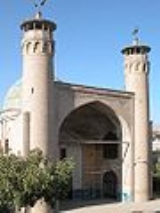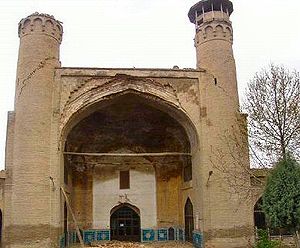
Jame Mosque of Borujerd
Encyclopedia
- This article is about Jameh Mosque of Borujerd; for similar uses, see Jameh Mosque (disambiguation).
The Jāmeh Mosque of Borujerd ( – Masjid-e-Jāmeh Borujerd) is a congregational mosque (Jāmeh) in Borujerd
Borujerd
Borujerd is a city in and capital of Borujerd County, Lorestan Province in western Iran. At the 2006 census, its population was 227,547, in 59,388 families....
, in the province of Loristan, western Iran
Iran
Iran , officially the Islamic Republic of Iran , is a country in Southern and Western Asia. The name "Iran" has been in use natively since the Sassanian era and came into use internationally in 1935, before which the country was known to the Western world as Persia...
. The mosque is the oldest mosque in the Zagros area and western Iran. It ranks as No. 228 in the Inventory of National Artefacts of Iran.
The mosque located in the old district of Borujerd
Borujerd
Borujerd is a city in and capital of Borujerd County, Lorestan Province in western Iran. At the 2006 census, its population was 227,547, in 59,388 families....
city previously called Do Dangeh. Jameh Mosque of Borujerd was built on an ancient fire-temple of the pre-Islamic Sassanid dynasty.
History
The construction of this mosque is attributed to a certain Hamuyeh, or Hamuleh, said to have been appointed by the Abi-Dolaf rulers as the governor of Borujerd in the 3rd century A.H. (9th century CECommon Era
Common Era ,abbreviated as CE, is an alternative designation for the calendar era originally introduced by Dionysius Exiguus in the 6th century, traditionally identified with Anno Domini .Dates before the year 1 CE are indicated by the usage of BCE, short for Before the Common Era Common Era...
). Judging by the evidences, continuous works of construction, reconstruction and restoration within the perimeter of the Jameh mosque of Borujerd are confirmed ever since the 3rd century up to the present; the culmination of this activity occurring in the Seljuk period. The architectural works done here in the 4th and 5th centuries have been compared – owing to the execution of the main pillars, the round based pseudo-columns, the brick decorations – to the mausoleum of Amir Esma’il the Samanid in Bukhara
Bukhara
Bukhara , from the Soghdian βuxārak , is the capital of the Bukhara Province of Uzbekistan. The nation's fifth-largest city, it has a population of 263,400 . The region around Bukhara has been inhabited for at least five millennia, and the city has existed for half that time...
. The plan of the mosque’s dome chamber and that of its secondary aisles at the corners of the perimeter have been likened to those of Heidaryyah Qazvin
Qazvin
Qazvin is the largest city and capital of the Province of Qazvin in Iran. At the 2006 census, its population was 349,821, in 96,420 families....
and the Jameh Mosque of Golpayegan. Assuming seven periods of restoration and essential repair, it is said that the most ancient part of the ensemble is its principle dome construction, now surrounded by adjunctions of later periods.
The portico and minarets of the Jameh mosque are said to have been built in 1209 AH (1794/5 CE), as an adjunction to its lofty arch built under Ma’mun and Mo’tassem. The religious and poetic inscriptions visible upon the entrance arch and on the wooden minbar and door of the mosque speak of these architectural alterations in the course of history.

Mihrab
A mihrab is semicircular niche in the wall of a mosque that indicates the qibla; that is, the direction of the Kaaba in Mecca and hence the direction that Muslims should face when praying...
. Beside the majesty and importance of this building and the delicacy of its architectural fabric, note must be made of the mosque’s nine-stepped minbar
Minbar
A minbar is a pulpit in the mosque where the imam stands to deliver sermons or in the Hussainia where the speaker sits and lectures the congregation...
, of particular importance. It was crafted by carpenter Dervish Yar-Muhammad upon an order from the Safavid king Shah Abbas II, and bears a poetic epigraph the last diptych of which gives, in Abjad figures, the construction date of the minbar [1069 AH = 1658/9 AD]. On the western entrance door, two other diptychs are carved, which beside the construction date of the mosque [1092 AH], gives the name of its builder.
Jameh mosque has been used as a religious, trading and social affair centre. The complex includes the Jameh Mosque used for Friday Prayer and public gatherings, Gharib Khaneh (an asylum for the poor and invalids), a Hammam (public bathhouse), a field and an Ab-Anbar (underground water storehouse). Most of these facilities have already been destroyed or replaced with modern streets and shops.
The mosque was bombed by Iraqi planes in 1980s and has been damaged by rain and earthquakes. Borujerd earthquake, March 2006
Borujerd earthquake, March 2006
The 2006 Borujerd earthquake occurred in the early morning of March 31, 2006 in the South of Borujerd with massive destruction in Borujerd, Silakhor and Dorood areas of the Loristan Province in Western Iran...
ruined its minarets and damaged it vastly. However, it is still one of the must-see places in Loristan and western Iran.
See also
- List of mosques in Iran
- Soltani Mosque of BorujerdSoltani Mosque of BorujerdThe Soltani Mosque of Borujerd is a large mosque in the centre of Borujerd, in the province of Lorestan, western Iran.The edifice was built in the Qajar period atop the ruins of an older mosque, which had been probably built in 10th century AD...
- Borujerd earthquake, March 2006Borujerd earthquake, March 2006The 2006 Borujerd earthquake occurred in the early morning of March 31, 2006 in the South of Borujerd with massive destruction in Borujerd, Silakhor and Dorood areas of the Loristan Province in Western Iran...

